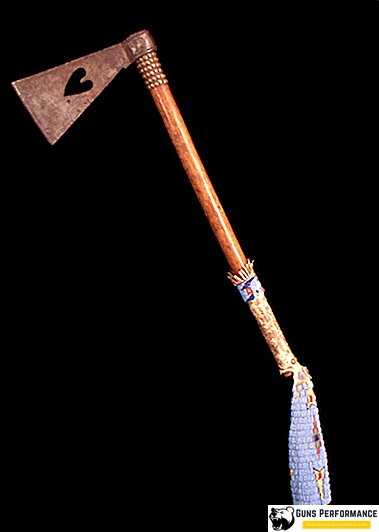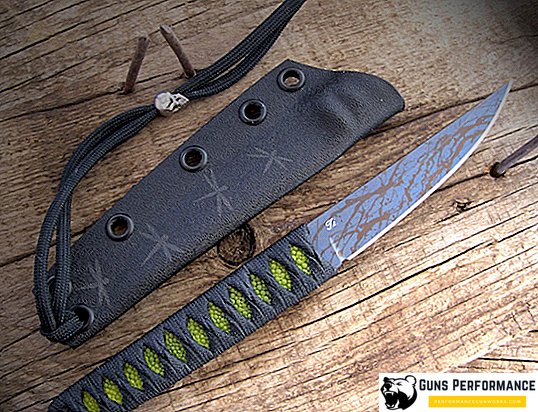
At the word "tomahawk" many immediately remember the Indians. Indeed, this type of ax masterly used by the North American aborigines. Reading books about Indians, it is difficult to get rid of the impression that a small steel hatchet is an original Indian invention. In fact, the Indians only gave their name to this ax, and he arrived in America with the colonists.
The first axes of the pre-Columbian Indians were stone, mounted on a long handle, often flexible or wicker. This ax was a hybrid ax with a club and was used in war and at home. Naturally, due to unreliable design, such weapons were inferior to spears. Seeing the sharp steel axes of the settlers, and having received a few in exchange, the Indians were delighted and called them "what they cut" (tamakhaken). The Europeans, having heard this word, pronounced it as “tomahawk”.
Varieties of Indian ax tomahawk
Although the tomahawk for the townsfolk is associated with the so-called "Missouri ax", the type of tomahawk could be different, in particular:
- Celts. The very first tomahawks of iron, which were hammered with an ax in the handle. To this group can be attributed the Celts with a tip, more resembled the nails;
- Tomahawks. Exactly those that advertised cinema and books about the Indians. Differently, they were called "Missouri axes" and represented the traditional form of an ax with an eye. Used for fighting, very rarely in everyday life (mainly for quick chipping of carcasses);
- Pipe tomahawks. Could be of any type, but had a feature - the channel along the entire length of the handle. Often richly decorated, rarely used in battle because of a hollow handle. Their main purpose was in diplomatic ceremonies between tribes, often given as a sign of friendship;
- Esponon tomahawks. They were a mixture of an axon and an ax. Most likely, they were altered from the Esponons, taken away in battles with the settlers;
- Halberd Tomahawks. They were brought from Spain, were either shortened halberds, or hatchets made in the same way. The most rare species, the North American Indians were mainly among the leaders, emphasizing their status.




Along with these models, there were self-made tomahawks. Usually they were made from standard models.
The emergence of steel tomahawks in the Indians
The first metal axes were exchanged by fur settlers. Having quickly learned how to master Tomahawks, the Aborigines outdid their teachers in this art. Basics of possession of the tomahawk Indians received from the British sailors who used axes in sea battles during boarding. Moreover, the Indians were able to master the throwing technique forgotten in Europe from the time of the Franks and even surpass the ancient Europeans. Masters of throwing could throw several tomahawks in a couple of seconds. For throwing most suitable Missouri type of ax. Spanish halberd type ax was suitable only for close combat. Throw an ax could be at a distance of 20 meters.
In contrast to the European battle ax, the tomahawk was not designed to break through the armor, however, during the heyday of the Indian wars, armor was no longer worn. Due to the low weight and relatively short handle, an ax could be used to inflict a lot of quick cuts in a battle with several opponents. Moreover, the tomahawk design allowed even a physically weak person to inflict deep, often fatal wounds.
Since the tomahawks were well bought up by the local aborigines, manufacturers began to produce axes, taking into account the preferences of specific tribes. It is worth noting that at first the axes were made of simple iron, and the eye did not penetrate, but was curved, followed by welding. Often these eyes burst at the most inopportune moment, especially in the cold.
To save space when transporting axes were not equipped with handles, which were made by the Indians himself. In the manufacture of handles, it was decorated with natives truly barbaric luxury. Everything that was at hand was used for decoration, from skin and wire to human hair and even scalps. Having no knowledge of metallurgy, the Indians could not independently upgrade the axes of the axes. Having learned this only at the beginning of the nineteenth century, they began to self-forge axes, giving them a more convenient form.
The civilized market instantly reacted to the demand and flooded the market with various models of tomahawks. The blades began to be made of steel, welded with the method of forge welding, the eyes began to be made with a piercer, and the blades themselves were decorated with holes and even inlays.
When a lot of Indian tribes were exterminated, and the rest were driven into reservations, the skill of owning a tomahawk was forgotten until it almost disappeared.
The revival of the tomahawk in the 20-21 centuries

The first to use a tomahawk began a descendant of the Indians Mohawk Peter LaGana. A participant in the Second World War, a marine and a hand-to-hand combat instructor, caught on the idea of creating a special army tomahawk for the US Army. Having created a perfectly balanced model with the help of children and women who, not possessing the skills, were able to work and throw the tomahawk quite effectively, Peter began to actively advertise his development. After a series of spectacular tests, in 1966, LaGana opened his company "American Tomahawk Company", which produced about 4,000 tomahawks. Almost all of them were acquired by the soldiers of the marines who participated in the Vietnam War. In this conflict, the tomahawk proved to be an excellent short-range melee weapon, securing the name "Vietnamese ax".
However, Peter’s plans to include the tomahawk in the standard set of marine equipment did not come true. After the Vietnamese conflict, the popularity of the tomahawk fell, and the company closed in 1970.

A new surge in the popularity of tomahawks came in the two thousand years, in connection with the fighting of the US Army in the east. To open the door, he came in handy. Now the so-called "tactical" tomahawk produces many companies and everyone can pick up an ax to suit their needs.
The disadvantages of modern models
Modern industry produces many types of tomahawks for every taste. From the frankly predatory SOG m48, to the completely peaceful-looking Jenny Wren Spike, touted as feminine. In general, modern tomahawks can be divided into three groups:
- Identical. Such axes are produced only by Cold steel. They are a forged hatchet on a wooden handle; they are put on by the reverse piercing method;
- Tomahawks attached to a plastic handle. This is the notorious SOG m48 and similar models;
- Tomahawks, cut from a single piece of metal, with lining in the handle.


Let us consider in more detail the advantages and disadvantages of each type.
Identical tomahawks are a classic construction of the ax, which has remained unchanged for hundreds of years. Usually made by themselves or ordered from blacksmiths. Despite the nondescript appearance, they are a formidable weapon, proven by many battles over the centuries. They are distinguished by a simple design, perfect balancing, the ability to adjust the handle specifically to your hand and ease of repair. The ax itself is "not killed", and the handle is easy to do with your own hands.
Tomahawks on a plastic handle have a very formidable look. Due to their low weight, they can be operated at high speed. Butt is often made in the form of a hammer, a hammer or even a second blade. These axes during operation revealed many flaws. The knob often scrolls in the hand when struck, causing the blow to slide. Absolutely not suitable for throwing, despite the assurances of the sellers (the handle breaks down after several blows to the tree). Practically not suitable for household work. Tomahawk of this type is more suitable for scaring than for serious work.
Solid tomahawks can be called an ax with a stretch. Rather, it is an ax-shaped blade. Due to the special design and low weight of the working part, they are not able to fulfill the role of a powerful penetrating weapon. Very rub hand when using. Their only plus is precisely in the solid design, which is very difficult to break.
If you want to buy a genuinely real combat tomahawk, choose identical Cold steel firms, and better do it yourself or order from a blacksmith.
Cold steel tomahawks

Firm Cold steel has become famous for the production of knives, axes, swords and other weapons, which is a symbiosis of the best vintage models with the latest developments. Cold steel tomahawks are forged from 1055 steel and are able to cope with chopping and throwing. Despite a good reputation, as any serial product may need to be improved. Frequent backlash ax on the handle, it happens that it is bad in the hand. When buying, you should carefully inspect the purchased product, and after the purchase carry out a test cabin. If you need to fit the ax with better quality, enclose the skin and spread it with epoxy. If possible, try making a tomahawk yourself.
Drawing for the manufacture of tomahawk do it yourself
There are two ways to make your own tomahawk:
- Forging method;
- With the help of an ax donor, grinders and electric sharpening.
Let us consider in detail these two methods, after which we will understand how to make a handle.
For forging an ax you will need a horn and an anvil. The horn can be made from an old saucepan by drilling holes in the bottom and partially cutting off the side walls. For blowing air, you can use an old vacuum cleaner or a fan from a computer. As an anvil fit a piece of old rail.

For an ax suitable metal brand 65g. As an alternative source of steel, you can perekovat automotive springs. First, a rectangle of suitable thickness is forged, and an eyelet hole is made in it using a chisel or piercer. Then blacksmith (or ordinary) hammer billet given the desired shape. The workpiece is hardened, after which the metalworking is performed.

Hardening forged tomahawk should be a zone - the blade is hardened, but the butt is usually not hardened. After the locksmith processing, the ax is placed on a previously prepared ax.
To make a tomahawk, you will need a donor - an ordinary ax. As the first prototype can take a cheap Chinese ax. Only a quality tool out of it will not work. Although if you are afraid to spoil a quality ax, you can try it in Chinese.
If you want to get a quality tomahawk, use the old Soviet forged axes. Axes from army warehouses of the forties and fifties of release enjoy good fame.

First you need to make a drawing of a tomahawk. To do this, the donor falls on a piece of paper and is circled around the contour. Then this pattern is given the desired shape. The next step is to transfer the drawing from the paper to the ax. Having drawn the desired shape on the ax, the excess metal should be cut with a grinder. When cutting, be sure to use safety glasses and gloves. You should not cut it too quickly, otherwise the metal will overheat and lose quenching. It is recommended to periodically cool the part with water. After trimming, the workpiece is sharpened on an electric sharpener and ground. If you have a Dremel, you can decorate the ax with an inscription or a picture. If the metal is overheated during the work, the ax needs to be re-hardened.
Tomahawk handle making
Usually, ax handles are made of birch, but for a tomahawk it is better to choose another wood. Cold steel uses hickory wood for tomahawk handles. In our latitudes, the best wood for toporishcha is ash. It is not inferior in strength to oak and at the same time has good flexibility. You can use dogwood, pear and cherry plum.
The tree for the tomahawk handle must be well dried. If this is not done, when the shrinkage is done, the ax will play and may even fly off the handle. When using the reverse vsada the probability of flying off the ax is excluded, but the backlash will greatly interfere with any work. You need to wedge the ax with a wooden wedge, in any case not iron.
Combat tomahawk - the legendary weapon of North American Indians, which has European roots. Qualitatively made ax will help in the march and will not let you down in any life situation.












